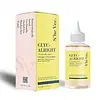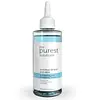What's inside
What's inside
 Key Ingredients
Key Ingredients

 Benefits
Benefits

 Concerns
Concerns

 Ingredients Side-by-side
Ingredients Side-by-side

Water
Skin ConditioningGlycolic Acid
BufferingGlycerin
HumectantPropanediol
SolventC12-13 Pareth-9
EmulsifyingNiacinamide
SmoothingRosa Damascena Flower Water
MaskingPhenethyl Alcohol
MaskingInulin
Skin ConditioningAloe Barbadensis Leaf Extract
EmollientPanthenol
Skin ConditioningCaprylyl Glycol
EmollientHydroxyethylcellulose
Emulsion StabilisingPotassium Sorbate
PreservativeSodium Hyaluronate
HumectantPanax Ginseng Root Extract
EmollientTasmannia Lanceolata Fruit/Leaf Extract
AntioxidantSodium PCA
HumectantSodium Lactate
BufferingFructose
HumectantArginine
MaskingAspartic Acid
MaskingHamamelis Virginiana Extract
AntiseborrhoeicPCA
HumectantPentylene Glycol
Skin ConditioningGlycine
BufferingAlanine
MaskingSerine
MaskingValine
MaskingProline
Skin ConditioningThreonine
Isoleucine
Skin ConditioningHistidine
HumectantPhenylalanine
MaskingAscorbyl Palmitate
AntioxidantWater, Glycolic Acid, Glycerin, Propanediol, C12-13 Pareth-9, Niacinamide, Rosa Damascena Flower Water, Phenethyl Alcohol, Inulin, Aloe Barbadensis Leaf Extract, Panthenol, Caprylyl Glycol, Hydroxyethylcellulose, Potassium Sorbate, Sodium Hyaluronate, Panax Ginseng Root Extract, Tasmannia Lanceolata Fruit/Leaf Extract, Sodium PCA, Sodium Lactate, Fructose, Arginine, Aspartic Acid, Hamamelis Virginiana Extract, PCA, Pentylene Glycol, Glycine, Alanine, Serine, Valine, Proline, Threonine, Isoleucine, Histidine, Phenylalanine, Ascorbyl Palmitate
Water
Skin ConditioningGlycolic Acid
BufferingPhenethyl Alcohol
MaskingPropylene Glycol
HumectantPanthenol
Skin ConditioningPPG-1-PEG-9 Lauryl Glycol Ether
EmulsifyingCoceth-7
EmulsifyingInulin
Skin Conditioning1,2-Hexanediol
Skin ConditioningParfum
MaskingTriethanolamine
BufferingPEG-40 Hydrogenated Castor Oil
EmulsifyingFructose
HumectantTetrasodium EDTA
Copper Gluconate
Skin ConditioningCitric Acid
BufferingSodium Hyaluronate
HumectantLactic Acid
BufferingAscorbic Acid
AntioxidantMalic Acid
BufferingGluconic Acid
Phenoxyethanol
PreservativeSalicylic Acid
MaskingTartaric Acid
BufferingEthylhexylglycerin
Skin ConditioningWater, Glycolic Acid, Phenethyl Alcohol, Propylene Glycol, Panthenol, PPG-1-PEG-9 Lauryl Glycol Ether, Coceth-7, Inulin, 1,2-Hexanediol, Parfum, Triethanolamine, PEG-40 Hydrogenated Castor Oil, Fructose, Tetrasodium EDTA, Copper Gluconate, Citric Acid, Sodium Hyaluronate, Lactic Acid, Ascorbic Acid, Malic Acid, Gluconic Acid, Phenoxyethanol, Salicylic Acid, Tartaric Acid, Ethylhexylglycerin
Ingredients Explained
These ingredients are found in both products.
Ingredients higher up in an ingredient list are typically present in a larger amount.
Glycolic Acid is arguably the most famous alpha hydroxy acid (AHA) with tons of research backing its benefits.
It is found naturally in sugar cane but the form used in skincare is usually synthetic for purity and stability.
Glycolic acid removes the top layer of dead skin cells to allow newer and fresher ones to emerge.
AHAs work by breaking down the structural “glue” that holds old skin cells in place. When that buildup is gone, your skin can renew itself more efficiently.
Research also shows glycolic acid stimulates collagen production, helping to firm and thicken the skin over time. This is one of its biggest advantages over other AHAs.
Overall, glycolic acid helps with:
Fun fact: Glycolic acid boosts skin hydration by helping it produce molecules that increase hyaluronic acid naturally.
To work best, glycolic acid products should have a pH between 3-4 (that’s where exfoliation is most effective but still gentle on skin).
The pH and concentration of a product are key to its effectiveness:
It is normal to feel a slight stinging sensation when using glycolic acid. This usually fades as your skin adjusts.
Because glycolic acid has the smallest molecular size in the AHA family, it can penetrate deeper, which enhances its effectiveness but also makes it more likely to irritate sensitive skin.
If your skin is very sensitive or prone to rosacea, glycolic acid may be too strong; in that case, try milder options like lactic acid or a PHA instead.
Recent studies suggest glycolic acid might even help protect against UV damage. But don’t skip sunscreen! Freshly exfoliated skin is more sensitive to the sun.
Glycolic acid is a skincare superstar. It smooths, brightens, hydrates, and firms the skin. Unless you’re highly sensitive, it’s well worth adding to your routine.
Read more about some other popular AHA's here:
Learn more about Glycolic AcidInulin is a polysaccharide (carbohydrate) with prebiotic and antioxidant properties.
The majority of inulin is extracted from chicory, but can also be obtained from other plants such as garlic, onion, asparagus, and sugarcane.
Studies show inulin may help with controlling your skin's natural microbiota when applied topically.
The antioxidant potential of inulin varies depending on the source.
Learn more about InulinPanthenol is a common ingredient that helps hydrate and soothe the skin. It is found naturally in our skin and hair.
There are two forms of panthenol: D and L.
D-panthenol is also known as dexpanthenol. Most cosmetics use dexpanthenol or a mixture of D and L-panthenol.
Panthenol is famous due to its ability to go deeper into the skin's layers. Using this ingredient has numerous pros (and no cons):
Like hyaluronic acid, panthenol is a humectant. Humectants are able to bind and hold large amounts of water to keep skin hydrated.
This ingredient works well for wound healing. It works by increasing tissue in the wound and helps close open wounds.
Once oxidized, panthenol converts to pantothenic acid. Panthothenic acid is found in all living cells.
This ingredient is also referred to as pro-vitamin B5.
Learn more about PanthenolPhenethyl Alcohol is a colorless and aromatic alohol. It is naturally occuring in essential oils.
The scent of this ingredient is floral and often compared to rose.
Like other alcohols, this ingredient helps prevent the growth of bacteria. However, its main purpose is to impact a fragrance.
Learn more about Phenethyl AlcoholSodium Hyaluronate is hyaluronic acid's salt form. It is commonly derived from the sodium salt of hyaluronic acid.
Like hyaluronic acid, it is great at holding water and acts as a humectant. This makes it a great skin hydrating ingredient.
Sodium Hyaluronate is naturally occurring in our bodies and is mostly found in eye fluid and joints.
These are some other common types of Hyaluronic Acid:
Learn more about Sodium HyaluronateWater. It's the most common cosmetic ingredient of all. You'll usually see it at the top of ingredient lists, meaning that it makes up the largest part of the product.
So why is it so popular? Water most often acts as a solvent - this means that it helps dissolve other ingredients into the formulation.
You'll also recognize water as that liquid we all need to stay alive. If you see this, drink a glass of water. Stay hydrated!
Learn more about Water